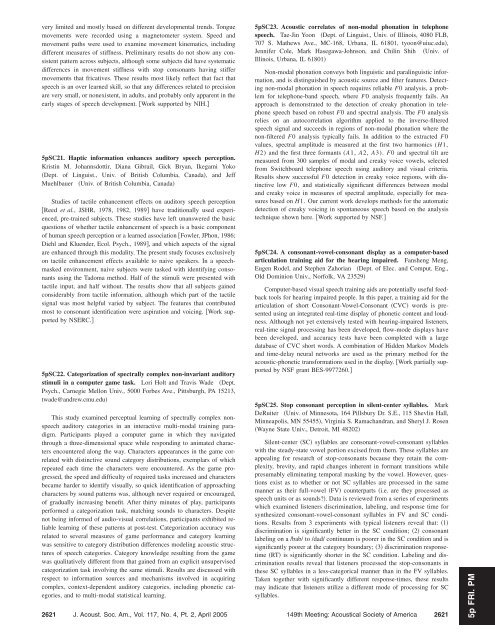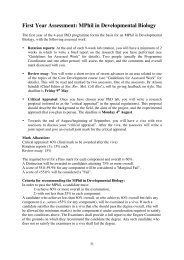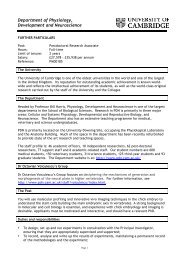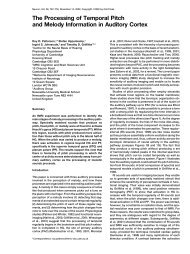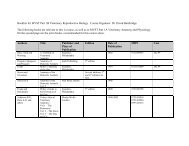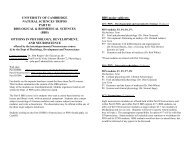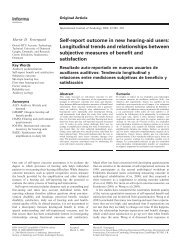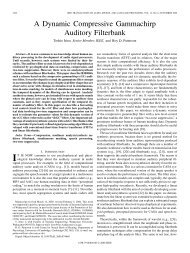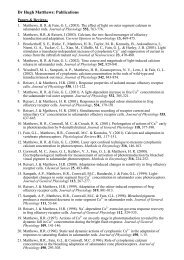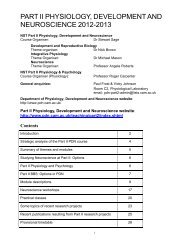FRIDAY MORNING, 20 MAY 2005 REGENCY E, 8:30 A.M. TO 12:00 ...
FRIDAY MORNING, 20 MAY 2005 REGENCY E, 8:30 A.M. TO 12:00 ...
FRIDAY MORNING, 20 MAY 2005 REGENCY E, 8:30 A.M. TO 12:00 ...
You also want an ePaper? Increase the reach of your titles
YUMPU automatically turns print PDFs into web optimized ePapers that Google loves.
very limited and mostly based on different developmental trends. Tongue<br />
movements were recorded using a magnetometer system. Speed and<br />
movement paths were used to examine movement kinematics, including<br />
different measures of stiffness. Preliminary results do not show any consistent<br />
pattern across subjects, although some subjects did have systematic<br />
differences in movement stiffness with stop consonants having stiffer<br />
movements that fricatives. These results most likely reflect that fact that<br />
speech is an over learned skill, so that any differences related to precision<br />
are very small, or nonexistent, in adults, and probably only apparent in the<br />
early stages of speech development. Work supported by NIH.<br />
5pSC21. Haptic information enhances auditory speech perception.<br />
Kristin M. Johannsdottir, Diana Gibrail, Gick Bryan, Ikegami Yoko<br />
Dept. of Linguist., Univ. of British Columbia, Canada, and Jeff<br />
Muehlbauer Univ. of British Columbia, Canada<br />
Studies of tactile enhancement effects on auditory speech perception<br />
Reed et al., JSHR, 1978, 1982, 1989 have traditionally used experienced,<br />
pre-trained subjects. These studies have left unanswered the basic<br />
questions of whether tactile enhancement of speech is a basic component<br />
of human speech perception or a learned association Fowler, JPhon, 1986;<br />
Diehl and Kluender, Ecol. Psych., 1989, and which aspects of the signal<br />
are enhanced through this modality. The present study focuses exclusively<br />
on tactile enhancement effects available to naive speakers. In a speechmasked<br />
environment, naive subjects were tasked with identifying consonants<br />
using the Tadoma method. Half of the stimuli were presented with<br />
tactile input, and half without. The results show that all subjects gained<br />
considerably from tactile information, although which part of the tactile<br />
signal was most helpful varied by subject. The features that contributed<br />
most to consonant identification were aspiration and voicing. Work supported<br />
by NSERC.<br />
5pSC22. Categorization of spectrally complex non-invariant auditory<br />
stimuli in a computer game task. Lori Holt and Travis Wade Dept.<br />
Psych., Carnegie Mellon Univ., 5<strong>00</strong>0 Forbes Ave., Pittsburgh, PA 15213,<br />
twade@andrew.cmu.edu<br />
This study examined perceptual learning of spectrally complex nonspeech<br />
auditory categories in an interactive multi-modal training paradigm.<br />
Participants played a computer game in which they navigated<br />
through a three-dimensional space while responding to animated characters<br />
encountered along the way. Characters appearances in the game correlated<br />
with distinctive sound category distributions, exemplars of which<br />
repeated each time the characters were encountered. As the game progressed,<br />
the speed and difficulty of required tasks increased and characters<br />
became harder to identify visually, so quick identification of approaching<br />
characters by sound patterns was, although never required or encouraged,<br />
of gradually increasing benefit. After thirty minutes of play, participants<br />
performed a categorization task, matching sounds to characters. Despite<br />
not being informed of audio-visual correlations, participants exhibited reliable<br />
learning of these patterns at post-test. Categorization accuracy was<br />
related to several measures of game performance and category learning<br />
was sensitive to category distribution differences modeling acoustic structures<br />
of speech categories. Category knowledge resulting from the game<br />
was qualitatively different from that gained from an explicit unsupervised<br />
categorization task involving the same stimuli. Results are discussed with<br />
respect to information sources and mechanisms involved in acquiring<br />
complex, context-dependent auditory categories, including phonetic categories,<br />
and to multi-modal statistical learning.<br />
5pSC23. Acoustic correlates of non-modal phonation in telephone<br />
speech. Tae-Jin Yoon Dept. of Linguist., Univ. of Illinois, 4080 FLB,<br />
707 S. Mathews Ave., MC-168, Urbana, IL 61801, tyoon@uiuc.edu,<br />
Jennifer Cole, Mark Hasegawa-Johnson, and Chilin Shih Univ. of<br />
Illinois, Urbana, IL 61801<br />
Non-modal phonation conveys both linguistic and paralinguistic information,<br />
and is distinguished by acoustic source and filter features. Detecting<br />
non-modal phonation in speech requires reliable F0 analysis, a problem<br />
for telephone-band speech, where F0 analysis frequently fails. An<br />
approach is demonstrated to the detection of creaky phonation in telephone<br />
speech based on robust F0 and spectral analysis. The F0 analysis<br />
relies on an autocorrelation algorithm applied to the inverse-filtered<br />
speech signal and succeeds in regions of non-modal phonation where the<br />
non-filtered F0 analysis typically fails. In addition to the extracted F0<br />
values, spectral amplitude is measured at the first two harmonics (H1,<br />
H2) and the first three formants (A1, A2, A3). F0 and spectral tilt are<br />
measured from <strong>30</strong>0 samples of modal and creaky voice vowels, selected<br />
from Switchboard telephone speech using auditory and visual criteria.<br />
Results show successful F0 detection in creaky voice regions, with distinctive<br />
low F0, and statistically significant differences between modal<br />
and creaky voice in measures of spectral amplitude, especially for measures<br />
based on H1. Our current work develops methods for the automatic<br />
detection of creaky voicing in spontaneous speech based on the analysis<br />
technique shown here. Work supported by NSF.<br />
5pSC24. A consonant-vowel-consonant display as a computer-based<br />
articulation training aid for the hearing impaired. Fansheng Meng,<br />
Eugen Rodel, and Stephen Zahorian Dept. of Elec. and Comput. Eng.,<br />
Old Dominion Univ., Norfolk, VA 23529<br />
Computer-based visual speech training aids are potentially useful feedback<br />
tools for hearing impaired people. In this paper, a training aid for the<br />
articulation of short Consonant-Vowel-Consonant CVC words is presented<br />
using an integrated real-time display of phonetic content and loudness.<br />
Although not yet extensively tested with hearing-impaired listeners,<br />
real-time signal processing has been developed, flow-mode displays have<br />
been developed, and accuracy tests have been completed with a large<br />
database of CVC short words. A combination of Hidden Markov Models<br />
and time-delay neural networks are used as the primary method for the<br />
acoustic-phonetic transformations used in the display. Work partially supported<br />
by NSF grant BES-9977260.<br />
5pSC25. Stop consonant perception in silent-center syllables. Mark<br />
DeRuiter Univ. of Minnesota, 164 Pillsbury Dr. S.E., 115 Shevlin Hall,<br />
Minneapolis, MN 55455, Virginia S. Ramachandran, and Sheryl J. Rosen<br />
Wayne State Univ., Detroit, MI 48<strong>20</strong>2<br />
Silent-center SC syllables are consonant-vowel-consonant syllables<br />
with the steady-state vowel portion excised from them. These syllables are<br />
appealing for research of stop-consonants because they retain the complexity,<br />
brevity, and rapid changes inherent in formant transitions while<br />
presumably eliminating temporal masking by the vowel. However, questions<br />
exist as to whether or not SC syllables are processed in the same<br />
manner as their full-vowel FV counterparts i.e. are they processed as<br />
speech units or as sounds?. Data is reviewed from a series of experiments<br />
which examined listeners discrimination, labeling, and response time for<br />
synthesized consonant-vowel-consonant syllables in FV and SC conditions.<br />
Results from 3 experiments with typical listeners reveal that: 1<br />
discrimination is significantly better in the SC condition; 2 consonant<br />
labeling on a /bab/ to /dad/ continuum is poorer in the SC condition and is<br />
significantly poorer at the category boundary; 3 discrimination responsetime<br />
RT is significantly shorter in the SC condition. Labeling and discrimination<br />
results reveal that listeners processed the stop-consonants in<br />
these SC syllables in a less-categorical manner than in the FV syllables.<br />
Taken together with significantly different response-times, these results<br />
may indicate that listeners utilize a different mode of processing for SC<br />
syllables.<br />
2621 J. Acoust. Soc. Am., Vol. 117, No. 4, Pt. 2, April <strong>20</strong>05 149th Meeting: Acoustical Society of America 2621<br />
5p FRI. PM


